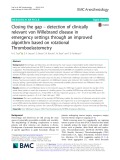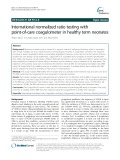
Coagulation screening
-
Hemorrhage and blood loss are still among the main causes of preventable death. Global hemostatic assays are useful point-of-care test (POCT) devices to rapidly detect cumulative effects of plasma factors and platelets on coagulation.
 9p
9p  vampires36
vampires36
 30-12-2021
30-12-2021
 10
10
 1
1
 Download
Download
-
Neonates routinely receive vitamin K to prevent vitamin K deficiency bleeding, which is associated with a high mortality rate and a high frequency of neurological sequelae. A coagulation screening test might be necessary to detect prophylactic failure or incomplete prophylaxis.
 6p
6p  vichengshin2711
vichengshin2711
 29-02-2020
29-02-2020
 9
9
 0
0
 Download
Download
-
The clinical diagnosis of inhibitor is suspected when patients do not respond to factor replacement at therapeutic doses. Inhibitors increase both morbidity and mortality in hemophilia. Because early detection of an inhibitor is critical to a successful correction of the bleeding or to eradication of the antibody, most hemophilia centers perform annual screening for inhibitors. The laboratory test required to confirm the presence of an inhibitor is an aPTT mixed with normal plasma. In most hemophilia patients, a 1:1 mix with normal plasma completely corrects the aPTT.
 5p
5p  thanhongan
thanhongan
 07-12-2010
07-12-2010
 59
59
 3
3
 Download
Download
-
Commonly used tests of hemostasis provide the initial screening for clotting factor activity (Fig. 110-1), and disease phenotype often correlates with the level of clotting activity. An isolated abnormal prothrombin time (PT) suggests FVII deficiency, whereas a prolonged activated partial thromboplastin time (aPTT) indicates most commonly hemophilia or FXI deficiency (Fig. 110-1). The prolongation of both PT and aPTT suggests deficiency of FV, FX, FII, or fibrinogen abnormalities.
 5p
5p  thanhongan
thanhongan
 07-12-2010
07-12-2010
 70
70
 2
2
 Download
Download
CHỦ ĐỀ BẠN MUỐN TÌM
















